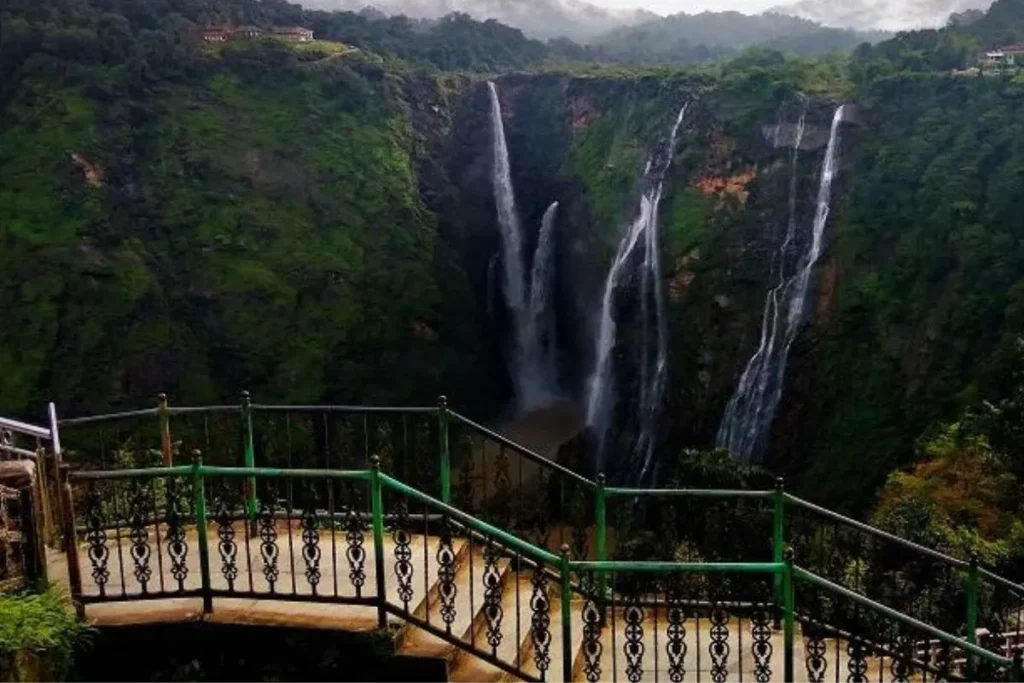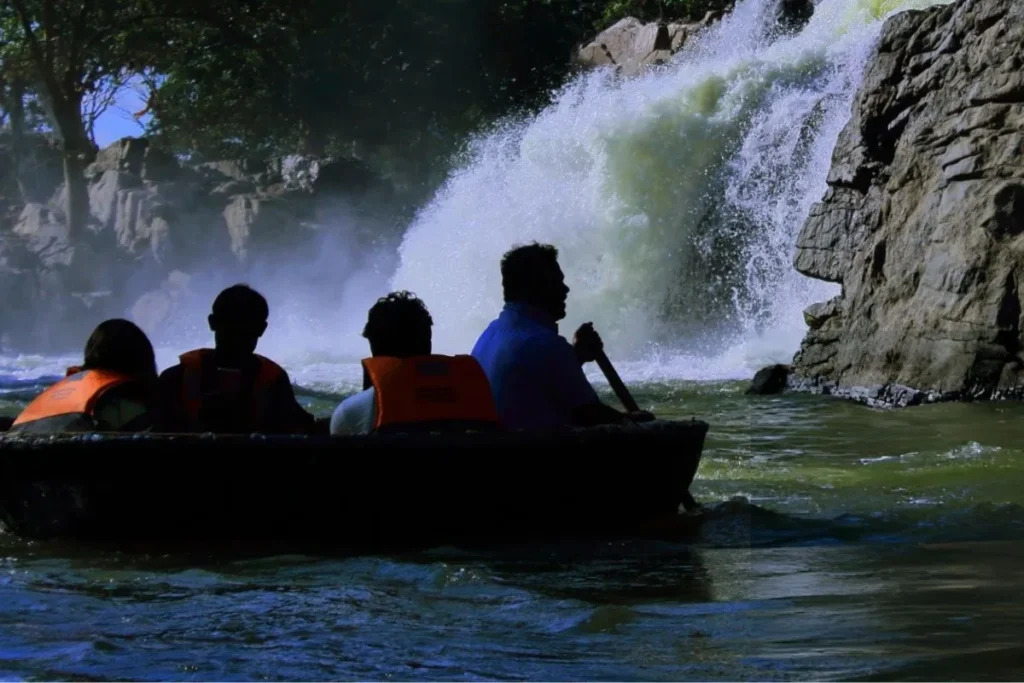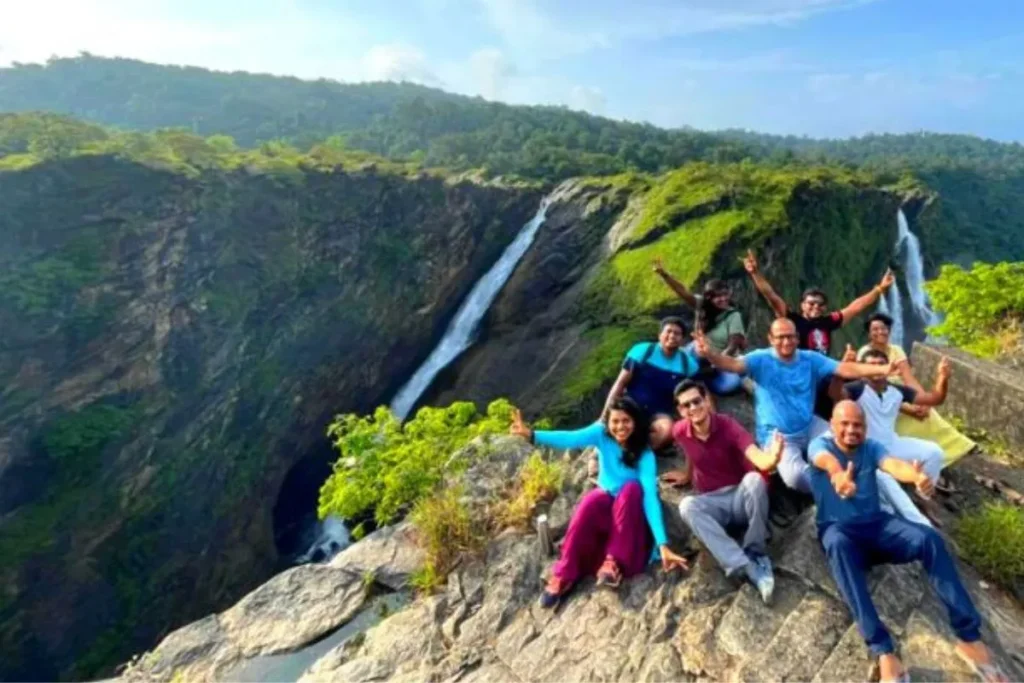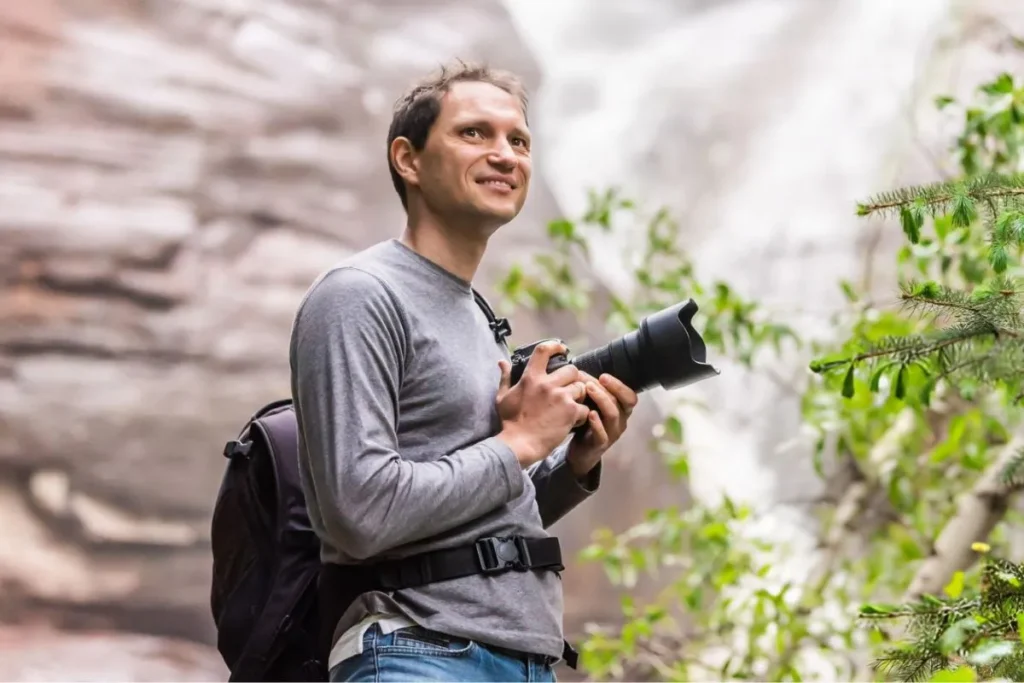Table of Contents
Jog Falls is India’s most beautiful natural attraction. Come see it for yourself. This beautiful waterfall is in the Western Ghats of Karnataka, which are very green. Jog Falls is the second-highest plunge waterfall in India. It is 830 feet high.
The thunderous roar of the falling water will meet you as you get closer to the falls. The falls’ sheer force and power make for an amazing show that will leave you speechless. I am truly amazed by the sight of water tumbling down the rocky cliff.
Jog Falls Overview
Location
- State: Karnataka
- District: Shimoga (Shivamogga)
- Nearest Town: Sagara (approximately 30 kilometers away)
Geographic Details
- River: Sharavathi River
- Height: Approximately 253 meters (830 feet)
- Type: Plunge waterfall
Features
- Jog Falls is comprised of four distinct cascades, locally known as:
- Raja: The largest and most majestic fall.
- Rani: Also known as Lady, it’s a thin stream.
- Roarer: Known for its powerful, roaring flow.
- Rocket: Known for its fast and thin jets of water.
Best Time to Visit
- Monsoon Season (June to September): The falls are in their full glory during the monsoon season, when the river is swollen with rainwater.
- Post-Monsoon (October to December): The flow is still substantial, offering excellent views and accessibility.
Tourist Attractions
- Viewing Platforms: There are multiple viewpoints from which tourists can view the falls. The best views are from the main viewpoint located near the parking area.
- Steps to the Base: There is a staircase with approximately 1,400 steps that leads to the base of the falls, providing a closer view of the plunge.
- Nearby Attractions:
- Linganamakki Dam: Located upstream of the falls, this dam is an important hydroelectric power station.
- Tunga Anicut Dam: Another nearby dam worth visiting.
- Sharavathi Wildlife Sanctuary: Rich in flora and fauna, offering a natural habitat for various species.
Accessibility
- By Road: Well-connected by road, accessible via buses and private vehicles from cities like Shimoga, Sagara, and Hubli.
- By Rail: The nearest railway station is Talguppa, around 13 kilometers from the falls.
- By Air: The nearest airports are Mangalore (around 180 kilometers away) and Hubli (around 133 kilometers away).
Conservation and Environmental Impact
- Jog Falls and the surrounding area are part of the Western Ghats, a UNESCO World Heritage Site known for its biodiversity. Conservation efforts are crucial to maintaining the ecological balance in the region.
Cultural Significance
- Jog Falls holds cultural and mythological significance for the local communities and is often featured in regional literature and folklore.
Tips for Visitors
- Safety: The rocks around the falls can be slippery, especially during the monsoon season. Exercise caution while trekking to the base.
- Photography: The best time for photography is early morning or late afternoon, when the light is soft.
- Weather: Carry appropriate rain gear if visiting during the monsoon season, and stay hydrated.
Jog Falls Cost
Visiting Jog Falls generally involves minimal costs, primarily associated with transportation, accommodation, and food. Here are some details regarding the potential costs involved in a trip to Jog Falls:
Entrance Fee
- Entrance Fee: Currently, there is no entrance fee to visit Jog Falls. However, this can change, so it’s a good idea to check for any updates before planning your visit.
Accommodation Costs
- Hotels and Lodges: There are various options ranging from budget to mid-range hotels in nearby towns such as Sagara and Shimoga. Prices can range from INR 500 to INR 3,000 per night depending on the type of accommodation.
- Resorts: For a more comfortable stay, resorts in the vicinity may charge higher rates, typically ranging from INR 3,000 to INR 6,000 per night.
Food Costs
- Local Restaurants and Eateries: Meals at local restaurants are usually affordable, with average costs ranging from INR 100 to INR 500 per meal.
- Resort/Hotel Dining: Dining in hotels or resorts might be slightly more expensive.
Additional Costs
- Guided Tours: If you choose to hire a guide for a more informative experience, this may incur additional costs.
- Souvenirs: Purchasing local crafts or souvenirs will add to the overall cost of the trip.
- Parking Fees: If you are traveling by private vehicle, parking fees may apply at the designated parking areas.
Estimated Budget
Here’s an estimated budget breakdown for a two-day trip for a single traveler:
- Transportation: INR 500 to INR 3,000 (depending on mode of transport)
- Accommodation: INR 1,000 to INR 6,000 (for 1-2 nights)
- Food: INR 300 to INR 1,000 (for 2 days)
- Miscellaneous: INR 200 to INR 1,000 (souvenirs, parking, etc.)
Tips to Save Costs
- Travel Off-Season: Visiting during the off-season can often result in lower accommodation costs.
- Group Travel: Traveling in a group can reduce per-person costs, especially for transportation and accommodation.
- Public Transport: Utilizing public buses and trains can significantly cut down on transportation expenses.
Location and Geological Formation
Jog Falls is in the Indian state of Karnataka, in the Shimoga district. This place is in the Western Ghats, a mountain range that runs along India’s western coast. The beautiful Jog Falls are made by the Sharavati River, which starts in the Western Ghats and runs through thick forests before crossing the cliffs and disappearing.
The rocks that make up Jog Falls are very different from each other. Instead of flowing down a hill, the water drops straight down from a very high point, making the falls. This kind of waterfall is called a plunge waterfall, and India’s Jog Falls is one of the tallest of them. The steep cliffside and the way the land naturally curves add to the grandeur and beauty of Jog Falls.
The Western Ghats are beautiful because they have a lot of different kinds of plants and animals. A lot of different plants and animals live in the woods nearby, including some rare and endemic species. Jog Falls is a great place for people who love nature and animals because it is so green and clean.
Height and Water Flow of Jog Falls
Many people are amazed by how high Jog Falls is and how much water runs over it. The falls are made up of four separate waterfalls, named Raja, Roarer, Rocket, and Rani. With a height of about 830 feet, the Raja waterfall is the tallest. Next to the Rocket and Rani waterfalls is the Roarer cascade, which is the second tallest.
The rainy season runs from June to September. This is when the most water flows over Jog Falls. From afar, you can hear the roaring sound of the water falling, which brings people from near and far. When the water hits the rocks hard, it makes a misty spray that adds to the falls’ surreal beauty.
During the dry season, Jog Falls has a lot less water flowing over it. But even at this time of year, the falls still have their amazing beauty. There are rocky rocks covered in moss and plants that make a beautiful background for the water falling. Every time people come, Jog Falls takes their breath away, no matter what time of year it is.
Read More Content: Athirappilly Water Falls Travel
History and Cultural Significance
The area’s history and culture are deeply connected to Jog Falls. The name of the falls comes from the village of Jog, which was the capital of the late Keladi kingdom and is close by. The rulers of Keladi held Jog Falls in great regard and saw it as a holy place.
Local stories say that the falls were caused by the curse of a wise man named Jamadagni. The beautiful Jog Falls were formed when the sage cursed a king named Ravana. The Sharavati River split into four streams. Since then, the falls have been seen as a sign of divine power, and the people who live there respect them.
Jog Falls was also very important in the growth of hydropower power in Karnataka. A British engineer named Sir M. Visvesvaraya saw that the falls could be used to make electricity and started building a hydroelectric power station in the early 1900s. At this point, the Linganamakki Dam and the Sharavati Hydro Power Plant use the falls’ power to make electricity for the area.
Because of its cultural and historical value, Jog Falls is a place that not only gives natural beauty but also a glimpse into Karnataka’s rich history.
Best Time to Visit Jog Falls
The best time to visit Jog Falls is during the monsoon season, from June to September. This is the height of the falls, when a huge amount of water flows over the rocks. The monsoon rains bring new life to the woods around, making the area green and lush. The mist that the waterfall creates adds to the magical atmosphere, making the experience truly mesmerizing.
But keep in mind that the weather can change quickly during the rainy season, and the paths around the falls may be very slippery and dangerous. If you plan to visit Jog Falls at this time, you should check the weather first and be careful.
If you’d rather have a more peaceful and less busy time, you could also go to Jog Falls after the rainy season, from October to December. The weather is nice, and the water flow is still pretty high. Not many people are there, so now is a great time to enjoy the beauty of Jog Falls and the woods nearby.
You can also go to Jog Falls during the dry season, which lasts from January to May. Even though the flow of water is much slower at this time, the falls are still very beautiful. The weather is warm and dry, so it’s a good time to do things outside and go hiking in the nearby places.
How to Reach Jog Falls
Jog Falls is easy to get to from Karnataka’s big cities and towns in nearby states, thanks to its good road system. About 150 kilometers away from Jog Falls is Mangalore International Airport, which is the closest airport. Your options for getting to Jog Falls from the airport are a cab or a bus.
Shimoga is the closest train station to Jog Falls. It has good connections to all of Karnataka’s big cities. Get to Jog Falls from Shimoga by car or bus.
National Highway 206 leads to Jog Falls if you’d rather travel by car. About 30 kilometers away from the falls is the town of Sagara, which is in the Shimoga area. You can get to Jog Falls from Sagara by private bus or cab.
There are designated parking places once you get to Jog Falls where you can leave your car. From there, you can walk to the lookouts and enjoy the stunning views of the falls.
Things to Do and See at Jog Falls
Visitors to Jog Falls can enjoy more than just seeing the beautiful waterfall. They can also enjoy the peace and beauty of the natural settings. At Jog Falls, you can do and see the following:
Viewpoints

There are several places at Jog Falls where you can enjoy the view and take beautiful pictures. The main lookout point is close to the gateway and gives you a wide view of the water falling. There are also other spots along the road where you can see the falls from different angles.
Tips for Visiting Viewpoints
- Best Time for Viewing: Early morning or late afternoon offers the best lighting for photography and a more serene experience.
- Safety: Exercise caution, especially near the edges of viewpoints and while descending the steps to the base. Rocks can be slippery, especially during the monsoon season.
- Facilities: Basic facilities like restrooms and snack stalls are available near the main viewpoints.
Nature Walks

You can take a slow walk along the well-marked paths near Jog Falls. Many kinds of plants and animals live in the woods nearby, which makes it a great spot for people who love nature. Watch out for the bright birds, butterflies, and other animals that live in this area.
Tips for Nature Walks
- Preparation: Wear comfortable walking shoes and dress in layers to adapt to changing weather conditions.
- Essentials: Carry water, snacks, and insect repellent. A small first aid kit can be handy.
- Guidance: Consider hiring a local guide, especially for longer or less clearly marked trails, to enhance your experience and ensure safety.
- Respect: Follow Leave No Trace principles to minimize your impact on the environment. Avoid disturbing wildlife and plant life.
- Safety: Be aware of your surroundings, especially in forested areas where wildlife may be present. Stick to marked trails and avoid wandering off.
Boat Ride

Taking a boat ride through the backwaters of the Sharavati River is a great way to get close to the falls. You can see the falls from a different angle from the boat ride, and as you get closer to the stream, you can feel the mist on your face.
Best Time to Visit:
- Post-monsoon (October to December), depending on water levels and local arrangements.
Tips for Boating
- Safety: Always wear a life jacket and follow the safety instructions provided by the operators.
- Bookings: It is advisable to book your boating activities in advance, especially during peak tourist seasons.
- Weather: Check the weather conditions before planning your boating trip, as heavy rains can affect water activities.
- Guided Tours: Opt for guided tours or organized boating activities for a safer and more informative experience.
Trekking

Trekking paths can be found in and around Jog Falls for people who like to take risks. You can see the falls from the trails, which go through dense woods and beautiful scenery. Getting to the bottom of the falls by foot is difficult but worth it because you can see how strong the water is up close.
Tips for Trekking
- Guides: Consider hiring a local guide who is familiar with the trails and can enhance your experience with their knowledge of the area.
- Permits: Some trekking routes may require permits, especially those within protected areas like wildlife sanctuaries.
- Safety: Ensure you have appropriate trekking gear, including sturdy shoes, rain gear, and sufficient water and snacks. Check weather conditions before embarking on your trek and inform someone about your itinerary.
- Respect Nature: Follow Leave No Trace principles, respect wildlife, and avoid littering or damaging the environment.
How to Reach Trekking Destinations
- By Road: Most trekking trailheads are accessible by road from nearby towns like Sagara, Shimoga, or Jog Falls itself. You can hire a taxi or use public transportation to reach these starting points.
- Accommodation: While some trekking trails can be completed in a day, others may require overnight stays. There are options for accommodation, ranging from homestays to guesthouses in nearby villages and towns.
Photography

Jog Falls presents endless opportunities for photography enthusiasts. For taking beautiful pictures, the misty air, the falls, and the nearby landscapes are all perfect backgrounds. Pack your camera and get pictures of Jog Falls from all sorts of angles.
Best Photography Locations
1. Jog Falls Viewpoints
- Main Viewpoint: Offers panoramic views of the falls and surrounding landscape.
- Watkins Platform: Provides a different angle and perspective of the falls.
- British Bungalow Viewpoint: Offers a serene setting with historical charm.
2. Linganamakki Dam
- Reservoir: Capture stunning reflections of the surrounding hills and forests in the calm waters of the reservoir.
- Dam Area: Photograph the massive structure of the dam against the backdrop of the Western Ghats.
3. Sharavathi Valley Wildlife Sanctuary
- Scenic Trails: Explore the various trekking trails and capture the lush greenery, streams, and waterfalls along the way.
- Wildlife: Keep your camera ready to capture sightings of elephants, deer, colorful birds, and other wildlife.
4. Honnemaradu Backwaters
- Golden Hour: Capture the soft golden light during sunrise and sunset over the tranquil backwaters.
- Reflections: Experiment with reflections of the surrounding landscape and vibrant skies in the calm waters.
Photography Tips
1. Light
- Golden Hours: Make the most of the soft, warm light during sunrise and sunset for stunning landscape shots.
- Overcast Days: Cloudy skies can add drama and texture to your photos, especially of waterfalls.
2. Composition
- Rule of Thirds: Use the rule of thirds to compose your shots, placing key elements off-center for a more dynamic composition.
- Leading Lines: Incorporate leading lines such as trails, rivers, or pathways to draw the viewer’s eye into the scene.
3. Equipment
- Wide-Angle Lens: Ideal for capturing expansive landscapes and the grandeur of Jog Falls.
- Tripod: Use a sturdy tripod to ensure sharp images, especially in low light conditions or when using slow shutter speeds for waterfall shots.
4. Perspectives
- Unique Angles: Experiment with different angles and perspectives to capture the falls and surrounding scenery from unique viewpoints.
- Close-Ups: Don’t forget to capture close-up shots of details like flowing water, foliage, and wildlife.
5. Weather
- Rainy Season: Embrace the drama of the monsoon season by capturing the falls at their peak flow, surrounded by lush greenery and mist.
- Clear Days: On clear days, focus on capturing the vivid colors of the landscape and the play of light and shadow.
Safety Tips for Visiting Jog Falls
Jog Falls is a beautiful natural sight, but you should always put your safety first when you’re there. Stay safe by remembering these things:
Observe Warning Signs
At the viewpoints and entry spots, pay attention to any warning signs or directions. The purpose of these signs is to keep you safe and tell you what to do and not to do while you are at Jog Falls.
Stay on Designated Trails
When you’re visiting Jog Falls, stay on the trails and lookout points that have been marked. When you leave the marked paths, it can be dangerous and cause crashes or injuries.
Wear Appropriate Footwear
During the rainy season, the paths around Jog Falls can be very slippery. Wear sturdy shoes with good grip to keep from slipping and to make walking more comfortable.
Stay Hydrated
Bring enough water with you to stay hydrated, especially if you want to go trekking or visit the area. It’s important to drink enough water, especially when it’s hot and dry outside.
Follow Wildlife Guidelines
Any animals you see at Jog Falls should be kept at a safe distance, and you should not feed or bother them. Please stay out of the wildlife’s natural environment and watch them from afar.
If you follow these safety tips, you can enjoy your trip to Jog Falls without worrying about your health. You can also help protect the falls’ natural beauty.
Nearby Attractions and Accommodations
There are many other interesting places to see near Jog Falls that you should check out during your trip. Here are some places close by that you can visit:
Sigandur
One of the most famous places in Sigandur is the old temple dedicated to Goddess Chowdeshwari. The village is about 20 kilometers from Jog Falls. It’s peaceful and sacred to visit the temple, which is right next to the Sharavati River.
Keladi
Keladi is an old town that is about 50 km away from Jog Falls. It is famous for being important in history because it was the home of the Keladi Nayaka dynasty. You can learn more about the history and customs of the area by going to the Keladi Museum.
Kodachadri
Kodachadri is about 60 kilometers away from Jog Falls and is a great place to go on a difficult hike. Kodachadri is a mountain peak with lovely views and thick woods. Adventure seekers like to go on the hike to the top of the mountain.
Honnemaradu
Honnemaradu is a beautiful lake that is about 40 km away from Jog Falls. The lake is surrounded by lots of trees and plants, and you can do water sports like canoeing and fishing there. Spend a day at Honnemaradu and do some fun things on the water.
There are a lot of different places to stay near Jog Falls, so there is something for every price and taste. The nearby towns of Sagara and Shimoga have a variety of places to stay, from high-end spas to cheap guesthouses. Some places to stay also have beautiful views of Jog Falls, so you can wake up to the sound and sight of this amazing waterfall.
Conclusion
You can see the stunning beauty of India’s Western Ghats at Jog Falls, a natural wonder. Everyone who visits Jog Falls will remember it for a long time thanks to its steep rocks, loud waterfalls, and lush green background. Anybody can enjoy Jog Falls, whether they’re looking for a quiet place to meditate or a thrilling journey.
Jog Falls is a place that will completely enchant you, whether you love nature, are looking for excitement, or just want to relax. If you want to make experiences that will last a lifetime, pack your bags and go to Jog Falls.
FAQ
What is Jog Falls famous for?
Jog Falls is the second-highest plunge waterfall in India, known for its immense power, thunderous roar, and scenic beauty.
Where is Jog Falls located?
Jog Falls is situated in the Western Ghats of Karnataka, India, near the town of Sagara in the Shimoga district.
What is the best time to visit Jog Falls?
The monsoon season (June to September) offers the most spectacular view with abundant water cascading down the falls. However, the post-monsoon period (October to December) provides good water flow with pleasant weather and fewer crowds.
How to get to Jog Falls?
Jog Falls is easily accessible by road from major cities in Karnataka and nearby states. The closest airport is Mangalore International Airport, and the nearest railway station is Talguppa.
Is there parking available at Jog Falls?
Yes, designated parking areas are available close to the falls.
What are the things to do at Jog Falls?
- Enjoy the breathtaking views from various viewpoints.
- Take a nature walk through the lush forests surrounding the falls.
- Experience the thrill of a boat ride on the backwaters of the Sharavathi River (during specific seasons).
- Go on a challenging trek down to the base of the falls (with proper guidance).
- Capture stunning photographs of the majestic falls and surrounding landscapes.
Is there an entrance fee to visit Jog Falls?
Currently, there is no entrance fee to enter Jog Falls. However, it’s advisable to check for any updates before your visit.
What is the estimated budget for a trip to Jog Falls?
The cost can vary depending on factors like travel mode, accommodation type, and activities. A two-day trip for a single traveler can range from INR 2,800 to INR 9,300 (approx USD 35 – USD 115).
What safety precautions should I take while visiting Jog Falls?
- Pay attention to warning signs and stay on designated trails to avoid خطر (khatra – danger) zones.
- Wear sturdy shoes with good grip, especially during the monsoon season when the paths can be slippery.
- Maintain a safe distance from the edges of viewpoints and while descending the steps to the base.
- Be mindful of wildlife and avoid disturbing their habitat.
- Stay hydrated by carrying sufficient water, especially during hikes or hot weather.

